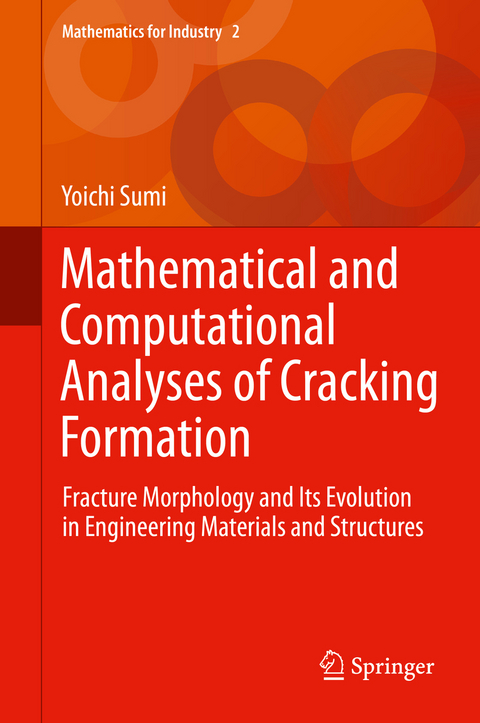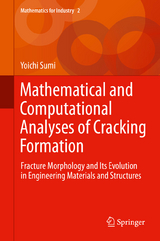Mathematical and Computational Analyses of Cracking Formation
Fracture Morphology and Its Evolution in Engineering Materials and Structures
Seiten
2014
|
2014 ed.
Springer Verlag, Japan
978-4-431-54934-5 (ISBN)
Springer Verlag, Japan
978-4-431-54934-5 (ISBN)
This book is about the pattern formation and the evolution of crack propagation in engineering materials and structures, bridging mathematical analyses of cracks based on singular integral equations, to computational simulation of engineering design. The first two parts of this book focus on elasticity and fracture and provide the basis for discussions on fracture morphology and its numerical simulation, which may lead to a simulation-based fracture control in engineering structures. Several design concepts are discussed for the prevention of fatigue and fracture in engineering structures, including safe-life design, fail-safe design, damage tolerant design.
After starting with basic elasticity and fracture theories in parts one and two, this book focuses on the fracture morphology that develops due to the propagation of brittle cracks or fatigue cracks.
In part three, the mathematical analysis of a curved crack is precisely described, based on the perturbation method. The stability theory of interactive cracks propagating in brittle solids may help readers to understand the formation of a fractal-like cracking patterns in brittle solids, while the stability theory of crack paths helps to identify the straight versus sharply curved or sometimes wavy crack paths observed in brittle solids.
In part four, the numerical simulation method of a system of multiple cracks is introduced by means of the finite element method, which may be used for the better implementation of fracture control in engineering structures.
This book is part of a series on “Mathematics for Industry” and will appeal to structural engineers seeking to understand the basic backgrounds of analyses, but also to mathematicians with an interest in how such mathematical solutions are evaluated in industrial applications.
After starting with basic elasticity and fracture theories in parts one and two, this book focuses on the fracture morphology that develops due to the propagation of brittle cracks or fatigue cracks.
In part three, the mathematical analysis of a curved crack is precisely described, based on the perturbation method. The stability theory of interactive cracks propagating in brittle solids may help readers to understand the formation of a fractal-like cracking patterns in brittle solids, while the stability theory of crack paths helps to identify the straight versus sharply curved or sometimes wavy crack paths observed in brittle solids.
In part four, the numerical simulation method of a system of multiple cracks is introduced by means of the finite element method, which may be used for the better implementation of fracture control in engineering structures.
This book is part of a series on “Mathematics for Industry” and will appeal to structural engineers seeking to understand the basic backgrounds of analyses, but also to mathematicians with an interest in how such mathematical solutions are evaluated in industrial applications.
Elastic Boundary-value Problems.- Stress Concentration Problems.- Analysis of Two-dimensional Cracks.- Brittle Fracture.- Fatigue Crack Propagation.- Pattern Formation of Interacting Brittle Cracks.- Crack Paths in Brittle Solids.- Brittle Fracture along Butt-Weld.- Fatigue Crack Paths.- Simulation of Crack Propagation.- Fracture Control of Engineering Structures.- Appendix.- Index.
| Erscheint lt. Verlag | 1.7.2014 |
|---|---|
| Reihe/Serie | Mathematics for Industry ; 2 |
| Zusatzinfo | 12 Illustrations, color; 156 Illustrations, black and white; XII, 282 p. 168 illus., 12 illus. in color. |
| Verlagsort | Tokyo |
| Sprache | englisch |
| Maße | 155 x 235 mm |
| Themenwelt | Mathematik / Informatik ► Mathematik ► Angewandte Mathematik |
| Mathematik / Informatik ► Mathematik ► Wahrscheinlichkeit / Kombinatorik | |
| Naturwissenschaften ► Physik / Astronomie ► Mechanik | |
| Technik ► Maschinenbau | |
| ISBN-10 | 4-431-54934-X / 443154934X |
| ISBN-13 | 978-4-431-54934-5 / 9784431549345 |
| Zustand | Neuware |
| Haben Sie eine Frage zum Produkt? |
Mehr entdecken
aus dem Bereich
aus dem Bereich
Buch | Softcover (2024)
Springer Vieweg (Verlag)
CHF 62,95
Anwendungen und Theorie von Funktionen, Distributionen und Tensoren
Buch | Softcover (2023)
De Gruyter Oldenbourg (Verlag)
CHF 97,90




